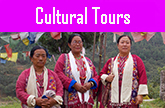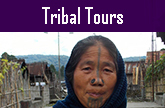North East India Heritage Tour
Tour Duration : 7 Nights / 8 Days
Travel Season : October to May
north east india heritage tour itinerary:
Day 01: Guwahati - Kaziranga National Park (217 kms, 4 & 1/2 hrs drive)
Meet upon arrival at Guwahati Airport / Railway Station.
Guwahati:
Guwahati, 'the city of Eastern light' stands on the southern bank of the mighty river Brahmaputra. It is the capital city of Assam and the gateway to the entire north-eastern states. Modern Guwahati is the hub city of Assam. It fulfills every aspect of a metropolitan city with its advanced means of transport, communication and media, as a major center of business activity, educational institutions, and various administrative and political activities of entire Assam. Besides, its landscape surrounded by hills and the mighty Brahmaputra River, rich and diverse flora and fauna enhances its natural scenic beauty.
If time permits, visit in Guwahati -
Kamakhya Temple:
Kamakhya Temple, one of the greatest 'Shaktipeeth', the shakti shrine of Goddess Kamakhya is situated on the Nilachal Hills. It is the oldest center of Tantric Shaktism. A famous legend regarding the birth of the Kamakhya temple narrates that Lord Shiva, rage with anger at his wife Sati's death, wandered the entire earth carrying Sati's corpse. An organ of Sati fell here and eventually the place became a temple of worship in due course of time. The temple features various stone inscriptions, terracotta works, sculptures and idols of Ganesha and Chamundeswari which are worth mentioning. The famous 'Ambubachi Fair' is celebrated with great enthusiasm every year in mid-June in this temple and devotees from different parts of India throng into it for the special occasion.
Later, take transfer to Kaziranga National Park.
Kaziranga National Park:
Internationally popular forest reserve and a UNESCO World Natural Heritage Site, Kaziranga National Park is situated on the northern banks of the mighty river Brahmaputra, spreading wide on both the Golaghat and Nagaon districts of Assam. It covers an area of over 430 sq km. Its landscape is characterized by swamps, beels, tall elephant grass, flat grasslands with streams.
Kaziranga National Park supports a variety of flora and fauna. It is mainly the undistributed residence of the Great One horned Rhinoceros. It is also a home to a large population of Indian Elephant, Wild Water Buffalo, Swamp Deer, Indian Boson, Royal Bengal Tiger, Sloth Bear, Hog Deer, Leopard Cats, Otter, Hog Badger, Capped Langur, Hollock Gibbons, Wild Boar, Jackal, Pythons, Monitor Lizard, and Fishing Cat etc. Small mammals like the rare Hispid Hare, Indian Gray Mangoose, Large Indian Civet, Small Indian Civet, Bengal Fox, Golden Jackal, Chinese Pangolin, Indian Pangolin, Hog Badger, Chinese Ferret Badger, Parti-colored Flying Squirrels etc. are also found here. Click in the link to view ->
kaziranga mammals check-list and
More than 500 species of birds have been recorded in Kaziranga National Park including 26 species of globally threatened category. Migratory birds like Lesser White Fronted Goose, Ferruginous Duck, Baer's Pochard Duck and Lesser Adjutant, Greater Adjutant, Black Necked Stork, Asian Openbill Stork etc. migrate to this park during the winter season every year. It is also a habitat of threatened species like Blyth's Kingfisher, White Bellied Heron, Dalmatian Pelican, Spot-billed Pelican, Nordmann's Greenshank, Black-Bellied Tern and other birds like the Eastern Imperial Eagle, Palla's Fish Eagle, Grey Headed Fish Eagle, Lesser Kestrel, Indian Vulture, Slender billed Vulture, Indian White-rumped Vulture, Swamp Francolin, Bengal Florican, Pale- Capped Pigeon, Black Breasted Parrotbill and Rufous vented Prinia etc. It is also a home to the endangered Gangetic Dolphin. Besides there are more than 40 species of fishes and 42 species of reptiles are found in Kaziranga National Park. Click in the link to view Clements Check-list of birds (6th edition, updated in 2012) found in Kaziranga ->
En-route visit -
Gajraj View Point and Kanchanjuri View Point
at Burha Pahar Range of Kaziranga National Park.
Arrive at Kaziranga and check-in jungle resort.
Overnight: Stay in jungle resort.
Day 02: Kaziranga National Park
Elephant Safari:
In the early morning, enjoy an elephant ride in the western range (Bagori) / central range (Kohora) of Kaziranga National Park.
In the late morning after breakfast, take a visit to the Ethnic Village of Kajir Ronghangpi Aklam, Kohora and explore the way of living of North Eastern People. Have a glimpse of Assam tea plantation. Observe the teams of colorfully dressed tea garden female workers plucking the delicate buds and leaves with their nimble fingers. Also, visit the company outlet of Hathikuli Tea Estate for purchasing different kinds of organic Tea.
Later visit -
Kaziranga National Orchid and Bio-diversity Park:
Witness more than 500 varieties of wild orchids collected from different parts of North-East Indian states, 132 species of sour fruits and leafy vegetables, 12 species of cane, 46 species of bamboo and a large variety of local fishes in Kaziranga National Orchid and Bio-diversity Park, located in Durgapur.
Also visit - Souvenir shops of bamboo and wooden products near Orchid Park at Kaziranga.
Jeep Safari:
In the afternoon post lunch, enjoy one round of Jeep safari in the central range (Kohora) / western range (Bagori) of Kaziranga National Park.
If interested, visit in the evening - Kaziranga Orchid Park again to enjoy special cultural show of different folk dances of Assam.
Overnight: Stay jungle resort.
Day 03: Kaziranga National Park - Majuli Island (113 kms, 2 & 1/2 hrs drive & 1/2 hr ferry ride)
Jeep Safari:
In the early morning, enjoy second round of Jeep safari in the central range (Kohora) / western range (Bagori) of Kaziranga National Park.
After breakfast, take transfer to Majuli Island. En-route cross - the Brahmaputra River by local ferryboat.
Majuli Island:
Majuli, the largest river island in the world, is being short listed for future status of UNESCO World Cultural Heritage Site. The formation of this river island dates back to 1691 AD, when a great flood swept Assam and created a new island in the midst of river Brahmaputra. Majuli is acclaimed mainly as the main centre of vaishnavite culture and satras of Assam. Srimanta Sankardeva, the Vaishnava saint and religious reformer of vaishnavism and his disciple Madhavdeva took forward the vaishnavite culture at Majuli. The first satra (monastery) was established at Belguri, the western part of Majuli.
The satras represent the preservation and propagation of socio-cultural ethics and ideals of Assam. There had been about 66 satras at Majuli. At present, only 31 of them are survived. These satras are great places of visit during the Raas festivals. Majuli also appeals tourists for its various attractions like rare seasonal migratory birds, display of various collection of traditional handicrafts, pottery, various ethnic dance forms, religious and mythological-based dramas etc.
At Majuli, a rare sight of Gangetic River Dolphin in the mighty Brahmaputra River may be an experience for lifetime.
Arrive at Majuli and check-in traditionally built Bamboo Hut. Later visit -
Auniati Satra:
Founded by Niranjan Pathakdeva, the main attraction of this vaishnavite satra are its Paal Naam Ceremony, Dashavatar dance and Puppet shows. The satra also offers a magnificent display of ancient collection of utensils, jewelry and handicrafts representing Assamese culture.
Evening: Free at relaxation. Overnight: Stay in Bamboo Hut.
Day 04: Majuli Island
In the morning after breakfast, have a full day excursion to visit -
Uttar Kamalabari Satra:
Uttar Kamalabari satra, a part of the actual Kamalabari Satra was founded by Padma Aata or Badula Aata, a disciple of Shri Shri Madhavdeva. It is a centre of Assamese art, culture and cultural studies. The satra is famous for Ankia Naat drama and Saali dance forms. It also has a branch in Guwahati. This branch has displayed Sattriya dance in many states of India and abroad.
Natun Samaguri Satra:
Globally famous for traditional art of mask making culture, Natun Samaguri Satra is a newly instituted branch of Samaguri Satra, originally established by Chakrapani Ata, an illustrious disciple of vaishnavite saints Srimanta Shankardeva and Shri Shri Madhavdeva. Experts of this monastery make masks for the performers of religious plays and also for decorative purpose. Masks crafted in this monastery are exported on demand made by the tourists from time to time.
Pottery culture:
Pottery is an ancient culture of Majuli. It is one of the traditional forms of cottage industry in Assam. At present, more than 4000 people at Majuli live on pottery culture for their livelihood. The potters at Majuli practice a peculiar technique in which they beat the clay by hand to make the utensils. Visit Kumhar Gaon to have a glimpse in the rural lives of the potters at Majuli working without the wheels which indicate a historic origin of this culture.
Mishing Tribal Village:
The Mishings are the largest ethnic tribal group in India. Earlier called Miris in the historical days, this group belongs to greater Tani people community, which comprises other Tani tribes such as Adi, Apatani, Nyishi, Padam, Minyong etc. in India and in Tibet Autonomous Region in China. The cultural, linguistic and ritual aspects of all Tani tribes are quite similar. The Mishings specifically belong to a Southeast Asian sub-race of the Mongoloid race. There are no written records about the migration of Mishings from hills to the plains of Assam. Historical and folklore sources regard that the Mishings were the Adis who migrated to Assam. Legend narrates of the Mishings coming in contact with the more civilized communities residing in the plains of Assam during early 16th century.
The Mishings originally believed the Donyi-Polo religion, but later on a majority of them converted to Hinduism and a minimal group took to Christianity. Ali-Aye-Ligang is the major festival of this tribe celebrated during the month of February. They also observe other festivals such as Pohrag and Dobur. Mishing culture exhibits traditional craft of weaving colourful cotton cloths. Mishing women weave cotton jackets, light cotton towels, endi shawls, thick loin cloths and shirting. Mishing women weave 'ege', 'rihbi', 'gaseng', 'gero', 'seleng gasor', 'riya', 'segreg' and 'potub'. All these are beautiful cloth sheets with broad & narrow stripes of bright contrastive colours worn by Mishing women. They also weave 'niseg' so that mothers can carry their babies in their back.
Deori Tribal Village:
The word 'Deuri' is derived from the word 'Deo' implying great and wise. Deoris are a major ethnic tribe of Assam. Their descendents were originally priests and worshippers whose source of livelihood was agriculture. The Deoris speak the Deori language. History suggests that Deori language was the original language in the Chutia kingdom before the advent of Ahoms in Assam. They construct their traditional stilt houses with bamboo, wood, cane, reeds etc. They belong to Hinduism who worships Hindu God and Goddess, Shiva and Parvati. The Deoris celebrate two major festivals - 'Bohagiyo Bisu' and 'Maghiyo Bisu' ie, Bohag Bihu and Magh Bihu respectively. At Majuli, Deori people are mainly concentrated in two Deori villages, namely Mai Deori village & Sriram Deori village near Jengraimukh.
Sonowal Kachari Village:
Designated to be the scheduled Bodo tribal community, Sonowal Kacharis form the third largest tribal group (plains) of Assam. They are primarily found in the districts of Dibrugarh, Tinsukia, Jorhat, Golaghat, Sibsagar, Lakhimpur and Dhemaji. It has been very difficult to trace the origin of Sonowal Kacharis over the years. It is popularly believed that a few population of the Kachari tribal community were occupied in cleaning gold elements from the sands of river during the reign of the Ahom rulers. Thus, the prefix 'Sonowal' meaning 'gold washer' was added before their main tribal identity 'kachari' to indicate their particular population. A famous anecdote recommends that during the rule of Ahom king Godadhar Singha, a 'Gossian' (meaning a priest) named 'Kechaideo' had mystical powers of contributing a definite quantity of gold in a bamboo tube. After becoming followers of 'Kechaideo', these people became popular as Sonowal Kacharis.
Sonowal Kacharis have 7 exogamous clans namely Chiripuria, Balikhitiari, Ujani-Kuchiya, Amarabamiya, Tipamiya, Dhulial and Namoni-Kuchiya. Yet again, these clans are sub grouped into 14 sub-clans namely Muktal, Hagral, Borttajoal, Madan, Ahmal, Manikiyal, Dhekial, Formal, Oingial, Saru Hazowal,Dangral, Kumral, Chetial and Lothial. Sonowal Kacharis are dedicated followers of Vaishnavism. Some prominent songs of Sonowal Kacharis are Husori, Haidang, Biya Naam, Aai Naam, Gossain Naam, Dhai Naam, Apeswara Naam and Lakhimi Naam. Some amazing traditional dance forms in addition to Bihu are Bohuwa dance, Kula-burhir dance and Hugra dance.
The Sonowal Kacharis presently do not have any particular dialect of their own. They commonly speak Assamese language. During Ahom rule, the Sonowal Kacharis in their course of integration with the non tribal communities adopted non tribal surnames like Bora, Saikia, Hazarika etc. Agriculture and poultry farming of rearing hens, ducks & cattle are the major occupations of Sonowal Kacharis. Drinking of Rice Beer is a popular habit among masses. Weaving at traditional ordinary weaving machines at home to produce items like endi chadar (silk cloth) and gamocha is a customary activity among women.
Later, enjoy a magnificent Sunset view in the Brahmaputra River from Ferry Point.
Overnight: Stay in Bamboo Hut.
Day 05: Majuli - Ziro (230 kms, 5 & 1/2 hrs drive & 1/2 hr ferry ride)
In the morning after breakfast, take transfer to Ziro. En route cross - the Brahmaputra River by local ferryboat.
Ziro:
A remarkable plateau and the abode of the Apatani people, Ziro set at a high altitude is renowned for its pine and bamboo grooves, Tarin, the high altitude fish farm, exotic landscape with a delightful view of sunrise from the hilltops, tribal culture and a centre of crafts such as cane and bamboo products. It is a perfect spot for adventure enthusiasts, offering endless experience for trekkers and hikers.
Arrive at Ziro and check-in hotel.
Evening: Free at relaxation. Overnight: Stay in hotel.
Day 06: Ziro
In the morning after breakfast, visit at Ziro -
Apatani tribal villages:
Hong, Hari, Hija, Duta, Bula, Tajang, Bamin Michi and Mudang Tage are eight distinctive Apatani villages situated at Ziro valley. Visit Hong village, the largest village of Apatani plateau and other Apatani villages as well. There are more than 5,000 people living in 700 houses at Hong village. In every village, there are some male community halls called 'Lapang'. Apatani people are famous for tattoo on their forehead and nose plug. Basically, Apatani people are animist who worship all natural gods. Donyi-Polo, i.e, the Sun and Moon is their supreme God. Apatani people are known for paddy cum pisciculture. They celebrate Myoko festival in the month of March for the welfare of their community and Dree festival in July for bountiful harvest, community well being and to keep away the pest.
Shiva Lingam:
The calm hills of Kardo hold one of the largest Shivalinga with a height measuring 25 feet and 22 feet in circumference. The Shivalinga excavated in the recent past is located near Hapoli town.
District Museum:
The District Museum at Zero exhibits a variety of handicrafts and textiles, musical instruments, weapons of the past ages used by different tribes and sub-tribes of Arunachal Pradesh. It displays an exclusive collection of art and craft, jewellery, variety of tribal headgears etc reflecting the traditions of ancient tribal culture.
Craft Center:
Craft Center showcases the unique crafts and handloom products of the Apatani tribe. A wide selection of craftsmanship is displayed in carpet weaving (woolen carpets) and traditional cloths exhibiting a tribal influence.
Regional High Altitude Fish Seed Farm:
Regional High Altitude Fish Seed Farm located at Tarin is a unique reflection of paddy and fish cultivation practiced by the Apatani tribe. The cultivation is carried out encompassing an area of 200 kilometers in Kamala valley. Tourists flock in this high altitude farm to view the distinctive farming covered by pine and bamboo grooves.
Overnight: Stay in hotel.
Day 07: Ziro - Itanagar - Nameri National Park (300 kms, 8 hrs drive)
In the morning after breakfast, take transfer to Nameri National Park via Itanagar.
Itanagar:
The historic capital city of Arunachal Pradesh, Itanagar stands on the dawn lit Himalayan foothills. A home to the Nyishi tribes, this town is located in the very midst of the state surrounded by traditional and modern wood-crafted tribal houses. Itanagar fascinates tourists to its rich archaeological and religious sites and its magnificent display of tribal arts, crafts and textiles.
If time permits, visit in Itanagar -
Ita Fort:
This ‘fort of bricks’ is located at the midst of the Itanagar town. The construction of this fort dates back to 1360 to 1550 A.D. during the rule of the Jitari dynasty. The structure of this fort is not regular in arrangement. This huge fort was built with more than 80lakhs of bricks and 45 centimeters of stone. The length of the complete brickwork of the fort is estimated to be about 16,200 cubic meters. It consists of three entrance gates on its eastern, western and southern sides.
Later, en-route stop -
Monabari Tea Estate:
Monabarie Tea Estate in Biswanath Chariali District of Assam is the World Biggest Tea Garden and Asia's Largest Tea Estate.The tea estate is owned by the McLeod Russel India Limited, a part of Williamson Magor Group.The Tea Garden Covers the Tea plantation area of 1158 hectares out of 1400 hectare of the total granted area. This tea garden produced 3150 tons crop per year. The Tea garden's workforce population is 2718.The Tea garden Manufactures 100% CTC Tea with 'Reddish Bright ' Quality. (Tip : Stop for a while and have some clicks posing in the tea plantations.)
If permission granted, en-route visit -
Tea Factory:
Visit a bought-leaf tea factory and witness processing of globally acclaimed Assam tea.
Naagsankar Temple:
There are many beliefs prevailing regarding the history of Naagsankar temple, a famous Shiva shrine located near Chotia. According to mythology, the powerful King Naagmatta (another name Arimatta), believed to be the son of river God Brahmaputra built the Naagsankar temple. Another belief states that King Naagsankar of Lohitya dynasty who ruled ancient Assam in 378 A.D. built this temple around 4th A.D. The renovation of the temple took place under the reign of Ahom King Su-Seng-Pha in 1480. The main attraction of the temple is a large pond adjacent to it inhabited by a wide variety of rare species of turtles and local fishes. Some turtles are believed to be around 100 years old. Being a Shiva shrine, Shivaratri is celebrated with great pomp and joy in this temple.
Later, drive to Nameri National Park.
Nameri National Park:
Nameri National Park is situated in the foothills of Eastern Himalayas and covers an area of about 200 sq km, stretching along both banks of the Jia Bhoroli River in the district of Sonitpur. The park is identified with its rich diversity of flora and fauna. It consists of semi-evergreen vegetation, moist deciduous forests and open grasslands along with about 600 species of flora.
It is the famous resident place for Asian Elephants. It is also a homeland to Royal Bengal Tiger, Leopard, Clouded Leopard, Indian Bison, Gaur, Wild Boar, Sloth Bear, Himalayan Black Bear, Capped Langur, Indian Giant Squirrel, Pygmy Hog, Indian Wild Dog and Civet Cat. Various beautiful birds like White Winged Wood Duck, Great Pied Hornbill, Wreathed Hornbill, Black Stork, Ibis Bill, Blue-bearded Bee Eaters, Babblers, Plovers, Rufous Necked Hornbill etc. are also found here.
Arrive at Nameri and check-in jungle cottage.
Evening: Free at relaxation. Overnight: Stay in jungle cottage.
Day 08: Nameri National Park - Guwahati departure (210 kms, 5 hrs drive)
Trekking:
In the early morning, enjoy guided trekking and bird watching inside the dense forest of Nameri National Park along with an armed forest guard.
After breakfast, drive to Guwahati. En-route cross -
Tezpur:
Tezpur, the 'city of love' is situated on the northern banks of the Brahmaputra River. The ancient name of Tezpur was Sonitpur, the kingdom of the mighty legendary king, Baan Raja. It was the capital city under his reign. Tezpur holds in its heart many ancient historical events, and witnessed many legends and mythological wars of ancient Assam. The occurrence of a famous war named 'Hari-Hara' is related with the attainment of the present day Tezpur. This battle led to the bloodshed of so many soldiers that the entire place was stained with blood and hence the city came to be known as Tezpur ('Tez' meaning blood and 'pur' meaning city in Assamese language). Present day Tezpur was founded by the British colonial administration in 1835 as the headquarters of Darrang district.
If time permits, visit at Tezpur -
Agnigarh:
Legend speaks of Agnigarh as a fortress built by Baan Raja in order to keep his daughter in isolation. The word 'Agnigarh' is a derivation of two Sanskrit words: 'Agni' meaning 'fire' and 'garh' meaning 'fort'. Situated on the north bank of the Brahmaputra River, it maintains its gracefulness with its lush green landscapes of the river. Nowadays, magnificent works of sculpture are depicted referring to the love story of Usha-Aniruddha and Great War 'Hari-Hara Juddha'.
Mahavoirab Temple:
Mahavoirab temple is the oldest Shiva shrine, where the second biggest Shiva linga of the world is worshipped. The temple was built by King Baan, the ruler of Sonitpur in 10th century. King Baan's daughter Princess Usha was a devotee of Lord Shiva and visited the temple for daily worship. Thousands of devotees gather during Shivaratri every year to offer prayers in this temple.
Later, take transfer to Guwahati Airport / Railway Station for your onward destination.
Tour terminates here
North East India Tourism
Package Inclusions:
# All ground transportation by a dedicated and exclusive vehicle driven by our experienced and friendly driver
# Nameri National Park entry fees & trekking fees
Package Exclusions:
# Any air fare or train fare


















